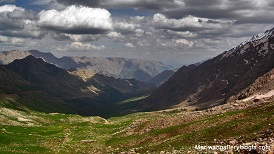
By Yasin Aziz:
An extract from Yasin’s forthcoming book, ‘A Few Days Life of Revolution in Halabja’
Hawraman, Ballanbow & Shnrwie
When Sajid was in secondary school, he wrote this:
When the window of life was wide open before me in Halabja in mid fifties, I found myself on the high ground, standing before three chains of mountains. They were often the sceneries of my leisure time for many years to come.
I have often been attracted by their views: grey, green, yellow, rusty, purple, white and heaps of dark shadows at late evenings or at night. The orange ambiance at dusk or the bright golden streaks of light at dawn often peered behind rocky ridges and peaks followed by the glaring sunshine into the midday summer’s heat.
When I was out in the surrounding plains, alone and kept looking up, for years and years I wanted to look into their folds to explore so many creases, shrubs and wood as if hidden from me so much I wanted to see. I often imagined their past, for so many hundreds of years they became our frontiers for many generations. We lived with their changing panoramic scenes, differing shades, tones, colours and moods in four-season.
That was paralleled to changing moods and stages of my growing up until when I left Halabja unexpectedly some years later.
For so many years they have been standing before us aloof and defiant in their enormousness, as though we were looking at each other in silence. It looked as if we would never get tired with each other’s company. The only difference was that, we were temporary inhabitants and they were the permanent lords of the land. I sometimes thought: ‘If only they could tell me in a way what they have witnessed in the past hundreds of years it would have been so fascinating, oh I pray to God if one day they would start to tell me about that’.
As there was a saying: ‘Every Castle has a story to tell’ one may consider every bit of these mountains may contain their own narrative. Throughout their past: from the Gooties and Parikani, Assyrians’ Zamwa to the Medes and Sassanid, these mountains must have witnessed passing of many different communities, many little villages and towns like Halabja.
Taking into account the rich history of the area, every yard of the area must have seen events: battles, encounters, many scenes of happiness or grief may never have been perceived.
Some people’s experience of being away for years would make them understand the extent of loving one’s own land, and would make them see from far away that there is such a strong bond to their native place.
What is in that place that has enchanted me so much, proved worthy of giving sacrifice for her protection? Here, in the cosy heaven of orchards, mountains, plains and the harmonious relations in the simplicity and satisfaction of the people living with whatever little they had.
People always wanted to be free as air, they often met as if hugged in the arms of these mountains and orchards, always with a longing to meet up for a national, a religious celebration or a ceremony, or simply for a chat, tease, laugh and freely shout at the top of their voices. That was how this scenery won their affection, as friends, family and relatives were longing for various annual ceremonies, or just for a chit chat, a laugh even for a silly argument.
This simple and innocent way of life when people so easily won others’ affection, just a ‘salam’ would be enough to make a friend, how generous was this social attitude? It was not only the beauty and mystery of the scenery that made one love the mountains, it was their end product. The way life has been formed within their folds for many years. One would clearly see people’s dejection after a social meeting when they said farewell to each other.
That feeling of togetherness has been formed over many years, that was why it was not easy to abandon it, even for the fear of death or being shot dead or blown apart by bombs. That was why, when someone died, everybody was ready to help in his burial ceremony, and when someone was poor they assisted with food and whatever they could.
If these people were just left alone, to get on with the way of life they chose, whatever we had, would have been enough, as our mountains, plains, springs and streams would have been sufficient to feed us. Oh the whiff of narcissus in spring, the glow of tender petals of red poppy flowers, many colourful wild flowers and roses, the orchards and cherry trees’ pink and white blossoms. The plains and hills sweet and colourful fruits of mulberry in late spring, the mountains’ oak, acacia and various shrubs nearby or far at a distance were like a heaven to one’s eyes in the misty air.
The colourfulness of the shops’ vegetables, fruits, with the perfume of narcissus, roses, Benefsaji flowers. The smell and spectacle of mellow fruits in summer and early autumn, various banquets of traditional food, the traditional dance, poetry and folk songs. The merry evening of Gullan and Mier garden, and the children’s summer nights gathering at someone’s door around a lamppost to sing, giggle and play ‘chawsharkie’ hide and seek until late when they had enough then went home into the silence of the night.
The underlying reason for one’s admiration was the town’s innocent and simplistic social relations, careful consideration for its neighbourhood calm and peaceful atmosphere reigning over its residences, the love and respect for Halabja the homeland for my heart and for the years of teenage love. That was why Halabja between these enormous mountains was just like a paradise, as in ancient history these mountains were revered like Devine providence. That was why for hundreds of years mountains have been looked up to as Kurds’ only friends…..
Yasin Mahmoud Aziz is from Halabja and lives in the UK. He is the author of ‘Dum Dum Castle’ and two books in Kurdish and he is planning several more books, including ‘A Few Days Life of Revolution in Halabja’.
Copyright © 2013 Kurdistantribune.com
.jpg)




What a wonder piece of writing. The sketches of the mountains, villages and the people is absolutely fascinating. Looking forward to reading the book.
Thanks a lot Kak Aras, I need to research it a lot, it might be sometime next year thanks